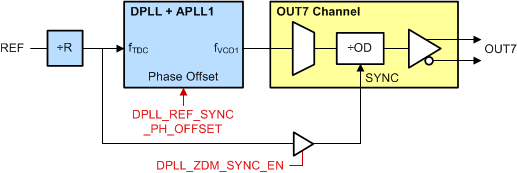ZHCSID6A December 2018 – December 2018 LMK05318
PRODUCTION DATA.
- 1 特性
- 2 应用
- 3 说明
- 4 修订历史记录
- 5 (说明 (续))
- 6 Pin Configuration and Functions
- 7 Specifications
- 8 Parameter Measurement Information
-
9 Detailed Description
- 9.1 Overview
- 9.2 Functional Block Diagram
- 9.3
Feature Description
- 9.3.1 Oscillator Input (XO_P/N)
- 9.3.2 Reference Inputs (PRIREF_P/N and SECREF_P/N)
- 9.3.3 Clock Input Interfacing and Termination
- 9.3.4 Reference Input Mux Selection
- 9.3.5 Hitless Switching
- 9.3.6 Gapped Clock Support on Reference Inputs
- 9.3.7 Input Clock and PLL Monitoring, Status, and Interrupts
- 9.3.8
PLL Relationships
- 9.3.8.1 PLL Frequency Relationships
- 9.3.8.2 Analog PLLs (APLL1, APLL2)
- 9.3.8.3 APLL Reference Paths
- 9.3.8.4 APLL Phase Frequency Detector (PFD) and Charge Pump
- 9.3.8.5 APLL Feedback Divider Paths
- 9.3.8.6 APLL Loop Filters (LF1, LF2)
- 9.3.8.7 APLL Voltage Controlled Oscillators (VCO1, VCO2)
- 9.3.8.8 APLL VCO Clock Distribution Paths (P1, P2)
- 9.3.8.9 DPLL Reference (R) Divider Paths
- 9.3.8.10 DPLL Time-to-Digital Converter (TDC)
- 9.3.8.11 DPLL Loop Filter (DLF)
- 9.3.8.12 DPLL Feedback (FB) Divider Path
- 9.3.9 Output Clock Distribution
- 9.3.10 Output Channel Muxes
- 9.3.11 Output Dividers (OD)
- 9.3.12 Clock Outputs (OUTx_P/N)
- 9.3.13 Glitchless Output Clock Start-Up
- 9.3.14 Clock Output Interfacing and Termination
- 9.3.15 Output Synchronization (SYNC)
- 9.3.16 Zero-Delay Mode (ZDM) Synchronization for 1-PPS Input and Output
- 9.4 Device Functional Modes
- 9.5 Programming
- 10Application and Implementation
- 11Power Supply Recommendations
- 12Layout
- 13器件和文档支持
- 14机械、封装和可订购信息
9.3.16 Zero-Delay Mode (ZDM) Synchronization for 1-PPS Input and Output
Zero-delay mode synchronization can be enabled to achieve zero phase delay between the selected DPLL reference input clock and the OUT7 clock as shown in Figure 52. This is primarily used to achieve deterministic phase relationship between a 1-PPS input and 1-PPS output. This feature can be configured through registers by enabling ZDM (DPLL_ZDM_SYNC_EN bit = 1) and enabling OUT7 divider synchronization (CH7_SYNC_EN bit = 1). The OUT7 clock must be derived from the DPLL and APLL1 VCO domain (fVCO1).
When the DPLL is not locked and the DPLL reference input is invalid, the OUT7 clock is held in mute state (no clock). Once the reference input is validated and selected, the OUT7 channel divider is reset or SYNCed using the DPLL reference input clock edge to achieve a deterministic phase relationship between the reference input and OUT7 clock. OUT7 is not affected by normal output SYNC events, and OUT[0:6] are not be affected by a ZDM SYNC event. The input-to-output phase offset can be adjusted through the DPLL phase offset register control (DPLL_REF_SYNC_PH_OFFSET bits). If the DPLL phase offset is programmed on-the-fly with 1-PPS input, it can take a long time to adjust due to the narrow DPLL bandwidth (10 mHz typical).
Hitless switching between 1-PPS inputs is not supported when ZDM is enabled. If a switchover event between 1-PPS inputs occurs when ZDM is enabled, a soft-reset should be issued for the DPLL to relock and realign the 1-PPS output to the selected input.
 Figure 52. DPLL ZDM Synchronization Between Reference Input and OUT7
Figure 52. DPLL ZDM Synchronization Between Reference Input and OUT7